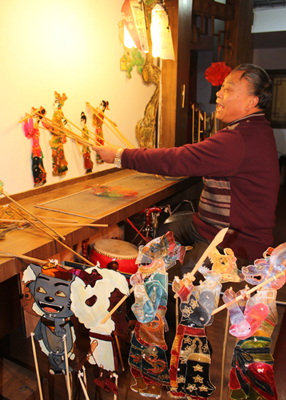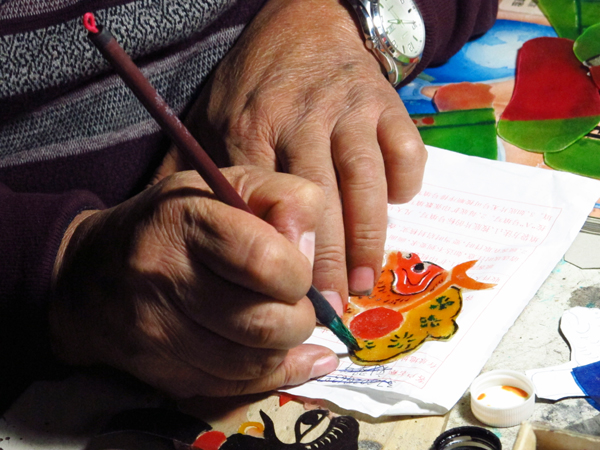Taishan's one-man show
Updated: 2012-01-15 09:52
By Zhang Zixuan (China Daily)
|
|||||||||||
While other regional puppet shows employ an entire troupe, in Shandong, it's one man's talent that drives the entire performance. Zhang Zixuan goes behind the scenes.
The show starts and gongs and drums sound backstage. Other instruments join the chorus, each different but all in harmony. The shadow puppets appear next, and fierce fighting and acrobatic moves earn applause from the audience.
With such action on stage and a coordinated orchestra backstage, it's natural to assume that there are several performers backstage making it all work.
But this is a one-man show.
 |
|
Photo by Wang Qian / China Daily |
"There are two ways to count the '10'. There are the eight percussion instruments, the singing and the puppetry, or it can mean the five senses, all four limbs and the brain," Fan explains.
The gongs, drums, cymbals and wooden knocker are combined into a music machine that can be operated by one man. It is self-made, and people who wander backstage to take a look are often amazed by the ingenuity.
The 67-year-old puppeteer says he was first captivated by the art when he saw his first shadow puppet show at the age of 8. At that time, shadow puppeteers from different regions in China had gathered at the foot of Mount Taishan. They would perform in sheds built from sorghum stalks.
As a child, Fan was a regular guest of one shed. The shed owner was Liu Yufeng and the young Fan thought he was the most magical man in the world. He could make the Eight Immortals in the classic tale Journey to the East come alive on stage.
But the young boy could not afford to buy the tickets which cost 5 fen (less than 1 cent). He sneaked into the performance by hiding among adult legs or making a hole in the sorghum walls. When he got caught, he would linger outside and listen through the walls.
Four years later, when Fan was 12, he dropped out of school and joined Liu on the road as his apprentice.
"Taishan puppetry is especially good at fighting scenes, and its most representative play is about a Taishan hero named Shi Gandang, who captured a lot of evil spirits," Fan is always enthusiastic about his favorite subject and he says he can talk about it for three days without stopping.
"The singing is strongly flavored by the Shandong dialect. And just as Shandong people never hesitate to show their true nature, Taishan puppets are very close to life."
 |
|
One man's talent steers the designing and making of the puppets, the singing and playing of the instruments and making the puppets come alive on stage. [Photo by Zhang Zixuan / China Daily] |
Refining tradition
For many years, Fan had been bothered by the deficiencies in the traditional one-man performance. He had promised the old master he would study and improve the techniques.
Traditionally, drums and gongs were hung by the sides of the canvas. When the puppets were being manipulated, the instruments stayed silent, and when they were being played, the puppets had to stay still. Only the wooden knocker, operated by the feet, could be played while the puppets were moving.
Fan's teacher, Liu, always had one or two assistants helping him and he had felt guilty about not being truly a one-man show. In 1999, on his deathbed, he had made Fan promise to recover the spirit of the solo performance.
"My teacher had eight apprentices, but he passed down all his puppets to me and only my name was engraved on his tombstone," Fan says, tears gathering in his eyes. "That was a huge trust."
In the years following, Fan devoted himself to finding the best solution. Inspired by the modern car's clutch and gears, he finally worked out a mechanical device that can connect all the percussion instruments, and can be operated by footwork.
"I did not add or remove any instruments - I simply moved them from above the table to below the table," he says with pride.
"Fan's innovation follows the traditional spirit and maintains its original matrix," says Wei Liqun, renowned shadow puppet expert. "It makes the performance richer and more dynamic."
"It's a fragile transition when many troupes bring shadow puppetry to a modern place that almost takes no roots from the traditional form. What Fan has done sets a good example of looking back to traditional form, design and engineering," says Annie Rollins, an American scholar of shadow puppetry who had watched Fan's performance during her 10-month field research in China.
Keeper of the legacy
In 2009, Fan was recognized as a State-level inheritor of Taishan solo shadow puppetry. He has been invited to perform in many foreign countries and in September 2010, he brought the art form to the UNESCO headquarters in Paris.
Just as like the other guardians of traditional heritage, Fan faces the problem of finding the right inheritors. There's a fine line between protecting the art heritage and making a decent living.
In 2009, Fan opened a teahouse where the public pays to see shadow puppet performances. Besides his 35-year-old son, he is also training three other apprentices and he pays them salaries.
"It's unreasonable to force young people to learn something that they cannot make a living from," he says.
But Fan also performs for free at benefit events at orphanages, nursing homes and schools and he is now working on a new play to publicize traffic safety regulations for Shandong province.
"I think now my teacher can rest in peace," he says.
You can contact the writer at zhangzixuan@chinadaily.com.cn.
Online: See more on www.chinadaily.com.cn
Related Stories
Living in the Shadows 2012-01-15 09:15
Shadow puppetry enters intangible heritage list 2011-11-27 19:49
Today's Top News
President Xi confident in recovery from quake
H7N9 update: 104 cases, 21 deaths
Telecom workers restore links
Coal mine blast kills 18 in Jilin
Intl scholarship puts China on the map
More bird flu patients discharged
Gold loses sheen, but still a safe bet
US 'turns blind eye to human rights'
Hot Topics
Lunar probe , China growth forecasts, Emission rules get tougher, China seen through 'colored lens', International board,
Editor's Picks

|

|

|

|

|

|





